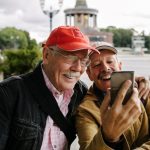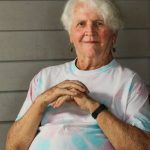This past July marked the 40-year anniversary of The New York Times story noting a rare cancer found in several dozen “homosexuals.” That cancer, of course, was Kaposi’s sarcoma, and the cause was a wiped-out immune system, caused by the yet-to-be identified and named virus HIV. While the next several years would reveal much about the virus and treatment approaches, only the most optimistic at the time believed that people with HIV would live for several more decades and beyond.
With the once-unthinkable a reality for most, provided they can access lifesaving meds, people who have had HIV for decades are hitting the big 6-0—or 7-0, or 8-0—with an awareness that living with the virus long term comes with its own unique challenges. Recognizing such challenges, California’s Gov. Gavin Newsom signed a law last month—the HIV & Aging Act—affirming that older adults with HIV are a target population in “greatest social need.” California wasn’t the first state to deem such a measure necessary; Illinois passed a similar law in 2019 that largely flew under the radar. Advocates insist California won’t be the last.
California’s HIV & Aging Act affirms people living with HIV (PLWH) are more likely to have multiple comorbidities and mental health issues as they age, and are more likely to need community-based services. That’s especially true for long-term survivors—and people who have been living with HIV for more than 25 years (pre-antiretroviral therapy) are likely to face even more health challenges, according to a report released last year by the HIV Aging Policy Action Coalition, an initiative launched by the nonprofit SAGE to grow awareness of the needs of older PLWH.
Effective treatment turns HIV into a chronic inflammatory disease, which over time can elevate the risk of many comorbidities, including hypertension, cancer, and bone diseases, to name a few. Intertwined with physical issues are emotional and mental health challenges, which may be worsened by stigma, limited social support, and even lingering trauma of having survived a pandemic when most of your friends died long ago.
Although Tez Anderson, founder of Let’s Kick ASS (AIDS Survivor Syndrome) is hardly socially isolated, he acknowledged that as a long-term survivor—of more than three decades—he’s aging at a faster rate due to his body fighting off the virus since 1983. “I’m 63, and experiencing symptoms of an older person,” said Anderson. “My energy level is drained without warning, partly due to the early medications I took back in the day. I have neuropathy in my hands and feet, which makes walking long distances painful. But fortunately, I have no bone density issues.”
In part because of ageism, Anderson said, older people often don’t receive adequate attention from society at large. “Older adults with HIV and AIDS are a majority of all people living with HIV in the U.S., but people think of HIV as a young person’s problem,” said Anderson. “Rather than being seen as an asset, we are seen as a burden.”
Anderson has used his lived experience as a long-term survivor with HIV to advocate for the passage and implementation of the new law and help California lawmakers and policymakers understand what’s at stake for older PLWH. He said he’ll continue to do what he can to ensure that the state Department of Aging puts older PLWH at the table.
Next Steps: Starting the Dialogue, County by County
The act, cosponsored by Equality California, SAGE, the Los Angeles LGBTQ+ Center, and APLA Health, amends a 2018 law, which designated older LGBTQ+ Californians as a “greatest social needs” population, to include older PLWH. That 2018 law was made possible by a 2012 amendment to the federal Older Americans Act of 1965 to include LGBTQ+ people as those with greatest social need because, in some communities, isolation due to sexual orientation or gender identity may restrict a person’s “ability to perform normal daily tasks or that threaten his or her capacity to live independently.”
The 2012 federal amendment to the Older Americans Act “gave permission to states across the nation to make a small but mighty change to improve the lives of older people living with HIV and LGBTQ+ older people in their communities,” said Aaron Tax, director of advocacy for SAGE. In 2012, Massachusetts was the first state to designate LGBTQ+ older people as a greatest social needs population. Pennsylvania followed suit earlier this year.
In practical terms, what will California’s new designation of older PLWH mean? The details remain to be worked out, say advocates. The law doesn’t have state money attached to it, which is one of the reasons the bill sailed through the legislature, according to its author, Sen. John Laird (D-Santa Cruz).
“[The act] is for existing senior programs, to make sure there is inclusion, outreach, and no stigma for older Californians living with HIV,” said Laird. As for exactly what that inclusion and outreach will look like, it depends somewhat on where people live and what services they seek. The law designates county departments of aging to inform and mandate inclusion of older PLWH in organizations that contract with the county. Laird added that most of the rollout will involve educating existing staff, but that a larger organization might use its own funds to hire HIV coordinators.
“The emphasis now is the conversation,” said Tax (of SAGE). “We’ll be part of that conversation to help [AIDS services organizations] better understand the needs of older people, and that LGBTQ+ organizations better understand the needs of older [PLWH].” Tax added that some social service organizations serving PLWH, LGBTQ+ people, and seniors, and the intersection of all three, may already be doing a good job with inclusion and cultural competency.
For Laird, one of the first openly gay elected officials in the U.S. and also the former director of the Santa Cruz AIDS Project, passing the law was personal. “In the early ’90s, before drug cocktails, it was our dream that people would live to old age with HIV,” he said. “Now that it’s a chronic condition, we want to make sure that [PLWH] who seek out senior services won’t feel like they have to go back into the closet.”
This article was originally published in TheBodyPro on August 20, 2021.







